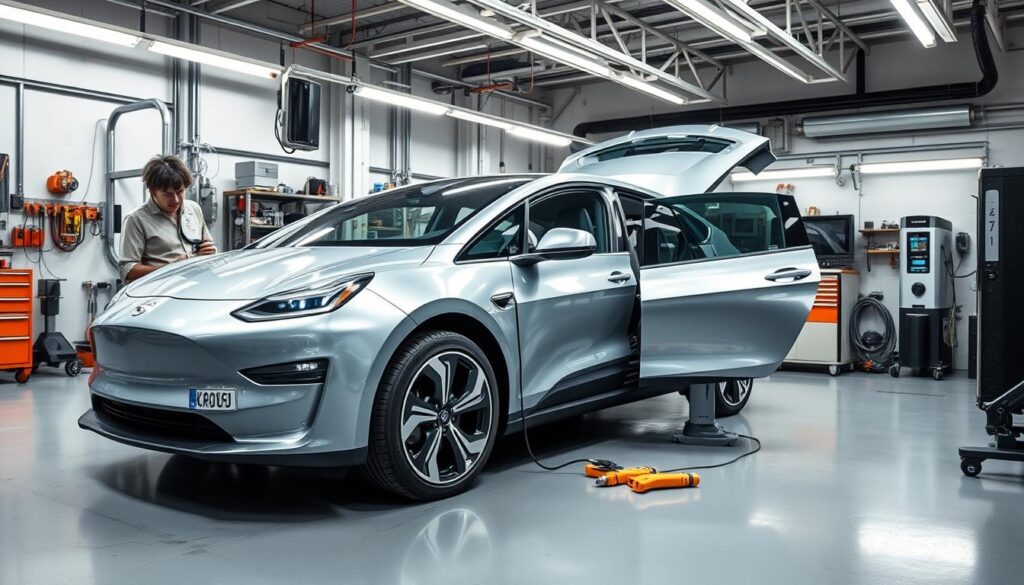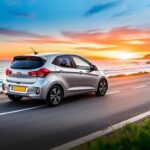The Indian electric vehicle (EV) market has seen big changes in recent years. Now, there are many affordable and feature-rich options for those who care about the environment. In 2024, 8 electric cars under 15 lakhs are available, meeting different budgets and tastes.
These cars range from the small MG Comet EV to the versatile Tata Nexon EV. They offer great performance, range, and value. This makes them very appealing.
Some of the most popular electric cars under 15 lakhs in India include the MG Windsor EV, MG Comet EV, Tata Punch EV, Tata Tiago EV, and Tata Nexon EV. These cars are changing the game, offering eco-friendly transport that’s also budget-friendly. They come with advanced features and new technologies.
Key Takeaways
- India’s electric vehicle market offers a diverse range of affordable options under 15 lakhs in 2024.
- Popular models include the MG Windsor EV, MG Comet EV, Tata Punch EV, Tata Tiago EV, and Tata Nexon EV.
- Prices for these EVs vary from as low as ₹6.99 lakhs for the MG Comet EV to ₹15.49 lakhs for the Mahindra XUV400.
- These affordable electric cars cater to different budgets and consumer needs, providing a mix of performance, range, and features.
- The growing EV market and government initiatives are driving the adoption of budget-friendly electric vehicles in India.
Current State of Electric Vehicles in India
India’s electric vehicle (EV) market is growing fast. This growth comes from government support and more people wanting green cars. There are many new electric car models available, fitting different budgets and needs.
Growth of EV Market in India
The number of electric cars in India has jumped up lately. Many car makers are now offering electric models. Today, there are 45 electric cars for sale, meeting various tastes and budgets.
Prices for electric cars in India start at ₹7 lakh for the MG Comet EV. The most expensive is the BMW i7, priced at ₹2.5 crore. This range gives buyers many eco-friendly options.
Government Initiatives and Subsidies
The Indian government is pushing for more electric cars. The FAME II (Faster Adoption and Manufacturing of (Hybrid &) Electric Vehicles in India) scheme offers big incentives. These incentives help make electric cars more appealing.
Charging Infrastructure Development
Having enough charging spots is key for electric cars to become common. The government and private companies are working to add more charging points. Big cities are getting more charging stations, but smaller places still need more.
As electric cars become more popular in India, support from the government and more charging spots will help. This will lead to more green cars on the road, making India’s future cleaner.
Best Electric Car in India Under 15 Lakhs
The Indian electric vehicle market is growing fast. It offers many EV options for those on a budget. The MG Windsor EV, Tata Nexon EV, Tata Punch EV, and Tata Tiago EV are top picks under 15 Lakhs.
These budget-friendly EVs have cool features, new battery tech, and long drives. They’re great for those who want to go green and move to electric cars.
- MG Windsor EV: It goes up to 489 km on one charge, making it a favorite among electric car fans.
- Tata Nexon EV: With a range of 325-465 km, it’s a mix of power and price.
- Tata Punch EV: It’s known for its sleek design, over 300 km range, and techy inside. It’s a strong contender in the small EV market.
- Tata Tiago EV: At just 7.99 Lakh, it offers 250-315 km range. It’s a smart budget-friendly pick.
These top EV options meet different needs and budgets. They’re helping more people choose affordable electric vehicles in India.
MG Windsor EV: Leading the Pack
The MG Windsor EV is a top choice in India’s fast-growing electric vehicle market. It combines great performance, cutting-edge tech, and good value. This new electric car from MG is perfect for those who want a green, yet practical, vehicle under 15 lakhs.
Battery and Range Specifications
The MG Windsor EV has a 38 kWh battery pack. It can go up to 332 kilometers on a single charge, according to standard tests. With a strong 136 PS motor, it’s ready for daily drives and longer trips.
Features and Technology
- Aero-Lounge Seats with up to 135° recline for enhanced comfort
- Panoramic sunroof for an open, airy cabin experience
- 15.6-inch touchscreen infotainment system with advanced connectivity
- Wireless phone charging for added convenience
- Automatic climate control for a personalized driving environment
The MG Windsor EV also has many safety features. These include 6 airbags, electronic stability control, and a 360-degree camera. This makes driving safe and confident.
Price and Variants
The MG Windsor EV comes in three models: Excite, Exclusive, and Essence. The Excite starts at ₹9.99 Lakh*, and the Essence tops out at ₹11.99 Lakh*. There’s also a Battery As A Service (BAAS) program for a lower upfront cost.
The MG Windsor EV stands out with its top specs, luxurious interior, and fair prices. It’s a strong contender in the electric car market, appealing to those who care about the environment and value.
Tata's Electric Portfolio: Nexon EV and Punch EV
Tata Motors is a top Indian car maker. They’ve made big steps in electric cars with the Nexon EV and Punch EV. These cars are loved by those who care about the planet. They offer great performance, features, and are easy on the wallet.
The Tata Nexon EV shows Tata’s dedication to electric cars. It can go 275-489 km on one charge. Starting at ₹12.49 Lakh, it has cool tech and safety, like 6 airbags and an overspeed warning.
The Tata Punch EV is another great choice. It’s small but powerful, with a range of 315-421 km. Starting at ₹9.99 Lakh, it’s a smart pick for city driving. Both cars have a 5-star Bharat NCAP safety rating, giving owners peace of mind.
| Model | Range (km) | Battery Capacity (kWh) | Price (₹ Lakh) |
|---|---|---|---|
| Tata Nexon EV | 275-489 | 30.2 | 12.49-19.94 |
| Tata Punch EV | 315-421 | 35 | 9.99-15.49 |
The Tata Nexon EV and Tata Punch EV are top picks in India. They have amazing features, are safe, and are priced right. Tata is a leader in making cars that are good for the planet.
Budget-Friendly Option: Tata Tiago EV
If you’re looking for an affordable electric hatchback, the Tata Tiago EV is a great choice. It costs between ₹7.99 lakh to ₹11.49 lakh (ex-showroom). This makes it the most budget-friendly EV in India.
Performance Metrics
The Tata Tiago EV comes with either a 19.2kWh or a 24kWh battery pack. It has a driving range of 250km to 315km on a single charge. Its electric motor produces 60bhp or 74bhp, with 110Nm or 114Nm of torque.
This ensures a quick and responsive drive, perfect for city streets.
Value Proposition
The Tiago EV offers great value, with features like regenerative braking and multiple driving modes. It also has a spacious cabin. Its compact size and agile handling make it great for city driving.
It also has a safety rating of 4 stars from Global NCAP. This gives you peace of mind for you and your family.
Real-world Range Testing
Real-world tests show the Tiago EV range is efficient. The 24kWh variant can go up to 315km on a single charge. This makes it a reliable choice for daily commutes and short-to-medium distance trips.
In summary, the Tata Tiago EV is a budget-friendly and reliable affordable electric hatchback in India. It offers a great mix of performance, features, and range for city drivers.
MG Comet EV: Compact City Commuter
The MG Comet EV is a budget-friendly electric car in India, priced at Rs. 7 – 9.65 Lakh (ex-showroom). It’s made for city driving, with a range of 230 km. This makes it perfect for daily city trips.
It has a 17.3 kWh battery and an electric motor in the back. The Comet EV gives 41.42 bhp of power. It charges from 0 to 100% in 3.3 hours with a 7kW charger, making it easy to top up during the day.
The car can seat up to 4 people and has dual airbags for safety. It comes in three variants: Executive, Excite, and Exclusive. There’s also a ‘100-Year Limited Edition’ available.
The Excite variant is the best deal, with features like dual 10.25-inch displays and a rear parking camera. It also has keyless entry and voice commands. The MG Comet EV comes in many colors, making it stylish for city driving.

The MG Comet EV is affordable, practical, and has modern features. It’s a great choice for those who want a compact electric car in India’s cities. It’s perfect for those who want a budget-friendly, efficient, and sustainable car.
Comparing Battery Capacity and Range
Electric vehicles (EVs) under 15 lakhs in India have different battery capacities and ranges. The EV battery comparison shows a wide range of choices. For example, the Tata Tiago EV has a 19.2 kWh battery pack for 250 km of range. In contrast, the Tata Nexon EV boasts a 30 kWh battery pack for up to 465 km of electric car range.
Short-range vs Long-range Options
Short-range EVs like the Tata Tiago EV and MG Comet EV are great for city driving. They are more affordable, making them a good starting point for EVs. Long-range EVs, such as the Tata Nexon EV and Citroen eC3, are better for longer trips. However, they cost more.
Charging Times and Options
Charging times for these EVs differ a lot. The Tata Tiago EV charges from 10-80% in 57 minutes with a DC fast charger. The Tata Nexon EV charges to the same level in 56 minutes. The MG Comet EV takes 7 hours to charge with a 3.3 kW charger. Fast-charging options are key for EV buyers.
“Tata Motors leads the market offering several mass-market EVs and potentially positioning themselves to dominate the market before competitors catch up.”
Safety Features and Ratings
The electric vehicle (EV) market in India is growing fast. Safety is now a key concern for car buyers. Electric cars in this market have many advanced safety features.
Top EV models like the Tata Nexon EV and Tata Tigor EV have passed tough crash tests. They got high safety ratings from global programs. For example, the Tata Tigor EV got a four-star safety rating from the Global New Car Assessment Programme (GNCAP).
These cars also have standard safety features like airbags, ABS, and electronic stability control. Some Indian EV models now have advanced driver assistance systems (ADAS). Features like 360-degree cameras and lane-keeping assistance add more safety and improve the driving experience.
As EV safety standards improve, car makers focus on adding strong electric car safety features. They aim to meet the growing need for safe and reliable electric cars in India.
| EV Model | Safety Features | Safety Ratings |
|---|---|---|
| Tata Nexon EV | Multiple airbags, ABS, EBD, Regenerative braking | 5-star GNCAP rating |
| Tata Tigor EV | Multiple airbags, ABS, EBD, Electronic stability control | 4-star GNCAP rating |
| MG ZS EV | 360-degree camera, ADAS, Multiple airbags, ABS, EBD | 5-star ASEAN NCAP rating |
| Hyundai Kona Electric | Multiple airbags, ABS, EBD, Hill-start assist | 5-star ASEAN NCAP rating |
Maintenance Costs and Ownership Experience
Electric vehicles (EVs) often have lower maintenance costs than cars with internal combustion engines. This is because EVs have fewer moving parts. This means they need less regular service and parts replacement. Also, EVs’ regenerative braking system helps brake parts last longer.
More service centers for EVs are opening up, thanks to Tata and MG. These companies have set up special service centers for electric cars. This makes it easier for owners to get the maintenance and repairs they need.
Battery Warranty Terms
Battery warranties are key for EV buyers. The battery pack is the most expensive part of an electric car. Most Indian manufacturers offer warranties on batteries ranging from 5 to 8 years.
Tata Motors gives an 8-year or 1,60,000 km warranty on its EVs’ battery and motor. MG offers a 5-year or 1,00,000 km warranty on the ZS EV’s battery. These warranties help buyers feel confident about their EV’s battery performance over time.
Total Cost of Ownership
Even though EVs cost more upfront, owning one can be cheaper in the long run. EVs save a lot on fuel and maintenance costs. For example, charging a Tata Nexon EV for 250-260 km costs about ₹150. This can lead to big savings over 5-6 years.
Also, EVs’ resale value is expected to go up as the market grows and battery tech improves. This makes owning an electric car even more cost-effective.
| Model | Battery Capacity | Range per Charge | Ex-Showroom Price |
|---|---|---|---|
| Tata Nexon EV | 30 kWh or 40.5 kWh | 325 km or 465 km | ₹14.74 – ₹19.99 Lakh |
| Tata Tigor EV | 26 kWh | 315 km | ₹12.49 – ₹13.75 Lakh |
| Mahindra XUV400 EV | 34.5 kWh or 39.4 kWh | 375 km or 456 km | ₹15.45 – ₹19.39 Lakh |
| MG ZS EV | 50.3 kWh | 461 km | ₹18.98 – ₹25.20 Lakh |
| Hyundai Kona Electric | 39.2 kWh | 452 km | ₹23.84 – ₹24.03 Lakh |

After-sales Support and Resale Value
The electric vehicle (EV) market in India is growing fast. This makes after-sales support and resale value very important. Companies like Tata and MG are working hard to ensure their EV customers get great service.
The resale value of EVs in India is changing. Battery health is a big factor. For example, the Tata Nexon EV keeps a good resale value of around ₹10.49 Lakh after 28,000 km. The Tata Tigor EV from 2022 also holds a value of ₹8.25 Lakh after 20,000 km.
Luxury EVs like the Mercedes-Benz EQS 580 4Matic and the Audi e-tron 50 Quattro have high resale prices. The EQS 580 4Matic can sell for ₹1.05 Crore, and the e-tron 50 Quattro for ₹58.75 Lakh, even after a lot of use.
How people see battery life and replacement costs affects EV prices. As more people trust EV batteries, resale values should go up. Also, more demand for used EVs, especially outside Western Europe, is good for the EV resale value in India.
The electric car after-sales service is still growing. But, car makers are really trying to help their EV owners. This, along with better resale values, looks promising for electric cars in India.
| Model | Resale Value | Mileage |
|---|---|---|
| Tata Nexon EV XZ Plus | ₹10.49 Lakh | 28,000 km |
| Tata Tigor EV XZ Plus | ₹8.25 Lakh | 20,000 km |
| MG ZS EV Exclusive | ₹18 Lakh | 27,153 km |
| Tata Nexon EV XM | ₹8.50 Lakh | 40,000 km |
| MG Comet EV Play | ₹6.90 Lakh | 8,900 km |
| Mercedes-Benz EQS 580 4Matic | ₹1.05 Crore | N/A |
| Audi e-tron 50 Quattro | ₹58.75 Lakh | 38,000 km |
The table shows the resale value and mileage of different electric cars in India. It highlights how important EV resale value is. Battery health and brand reputation play big roles in the second-hand market price.
Environmental Impact and Sustainability
India is moving towards green driving solutions and emission-free automobiles. Electric vehicles (EVs) are at the forefront, offering big environmental benefits. EVs cut down on carbon emissions a lot, especially when powered by renewable energy.
Carbon Footprint Reduction
Electric cars in India are very energy-efficient. They turn about 59%-62% of electrical energy into power for the wheels. This means a big drop in carbon footprint, especially in cities where air pollution is a big problem.
Recycling Programs
Now, car makers are working on recycling EV batteries. They want to get valuable materials back, cut down waste, and make EVs last longer. As EVs become more popular in India, recycling will help lessen the industry’s environmental impact.
EVs in India are good for the environment. They help clean the air and pave the way for a greener future in transportation. The government and car makers are expanding charging spots and pushing for more EVs. This will make the benefits of switching to EVs even bigger.
| EV Model | Range (km) | Price (₹ Lakh) |
|---|---|---|
| Mercedes-Benz EQB | 423 | 77.5 |
| MG ZS EV | 461 | 23 – 26 |
| Citroen eC3 | 320 | 11.5 – 12.4 |
| BYD E6 | 520 | 29.1 |
| Tata Tiago EV | 315 | 8.7 – 12 |
| MG Comet EV | 230 | 8 – 10 |
| Tata Nexon EV Max | 465 | 16.5 – 19.5 |
| Mahindra XUV 400 | 456 | 16 – 19 |
Conclusion
The Indian market for electric cars under 15 lakhs has a wide range of choices. From the MG Windsor EV to the Tata Tiago EV, these cars offer great performance and value. They meet different needs and budgets.
As electric vehicles in India grow, so does their appeal. With better technology and more charging spots, they’re becoming a smart choice. The demand for electric cars under 20 shows people want affordable, green transport.
Looking for a city car, SUV, or sedan? The best electric cars under 15 lakhs in India are exciting. They promise a green future for driving. As the industry keeps improving, electric cars will change how we travel and help the planet.
FAQ
What are the best electric cars in India under 15 Lakhs?
Top electric cars in India under 15 Lakhs include the MG Windsor EV and MG Comet EV. Also, the Tata Punch EV, Tata Tiago EV, and Tata Nexon EV are popular. These cars offer various features and ranges to fit different needs and budgets.
What is the current state of the electric vehicle market in India?
The EV market in India is growing fast. The government supports it with schemes and subsidies. The FAME II scheme helps buyers, and more charging spots are being added, especially in big cities.
What are the key government initiatives and subsidies for electric vehicles in India?
The FAME II scheme by the Indian government offers incentives for buying EVs. This has helped the EV market grow.
How is the charging infrastructure for electric vehicles developing in India?
Charging spots for EVs are increasing, thanks to public and private efforts. Big cities are seeing more stations. But, smaller towns and rural areas need more.
What are the key features and specifications of the MG Windsor EV?
The MG Windsor EV has a range of 331 km per charge. It comes with a panoramic sunroof and advanced tech. Prices start at 11.74 Lakh for the Excite variant, with other options available.
How do the Tata Nexon EV and Tata Punch EV compare?
The Tata Nexon EV has a range of 275-489 km and starts at 12.49 Lakh. The Tata Punch EV offers 315-421 km range, starting at 9.99 Lakh. Both have various variants and advanced features.
What are the key features and specifications of the Tata Tiago EV?
The Tata Tiago EV starts at 7.99 Lakh and has a range of 250-315 km. It’s great for city driving and efficient for daily use.
How does the MG Comet EV compare to other affordable electric cars in India?
The MG Comet EV is priced from 6.99 Lakh, making it very affordable. It’s designed for city driving and offers modern features at a low cost.
What are the differences between short-range and long-range electric cars under 15 Lakhs?
Cars in this range have ranges from 250 km (Tata Tiago EV) to 489 km (Tata Nexon EV). Long-range cars cost more but are better for long trips. Short-range cars are perfect for city use.
What safety features and ratings do electric cars under 15 Lakhs have?
These cars have safety features like airbags, ABS, and electronic stability control. Many have passed crash tests, with Tata vehicles known for their safety.
What are the maintenance costs and ownership experiences for electric cars under 15 Lakhs?
EVs have lower maintenance costs than ICE cars. Service networks are growing, with Tata and MG setting up EV-specific centers. Battery warranties last 5-8 years, giving buyers peace of mind.
How is the after-sales support and resale value for electric cars under 15 Lakhs?
EV after-sales support is getting better, with dedicated service centers and trained staff. Resale value is still evolving, with battery health being key. Brands are building strong networks to support their EV customers.
What is the environmental impact of electric cars under 15 Lakhs in India?
EVs significantly cut down on carbon emissions compared to ICE cars, especially when charged with green energy. Manufacturers are working on recycling EV batteries, making EVs even more eco-friendly in India.










